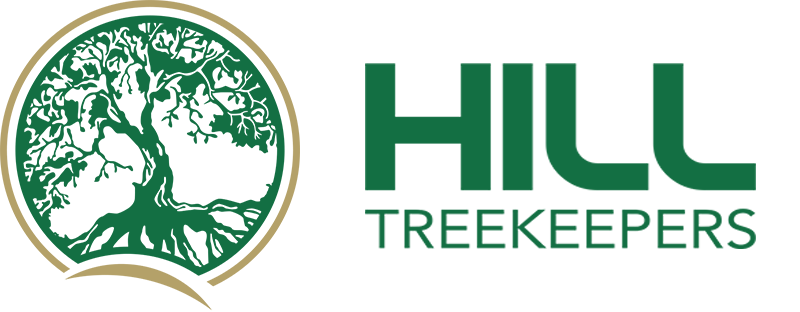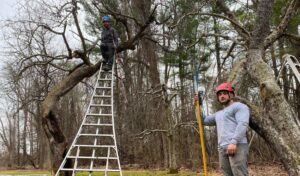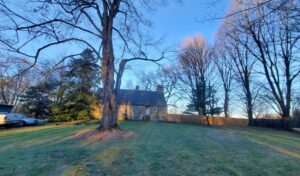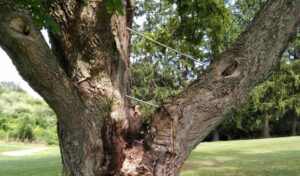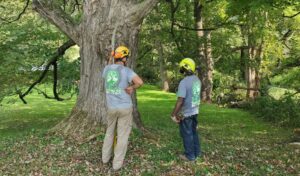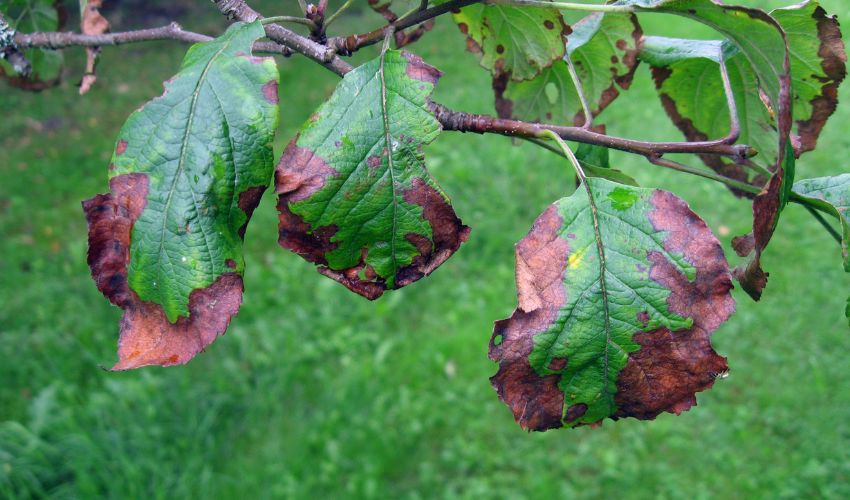
Trees, with their steady presence, often stand in the background, quietly producing shade, oxygen, and food, and protection for wildlife. Trees usually aren’t noticed unless they have showy colors (from fall leaves or spring blossoms) or if there is something wrong with them.
In the latter case, some issues can be resolved quickly with pruning, tree removals, storm damage cleanup, or other tree services. But what about when a pest or disease causes the issues?
In this article, we will share how you can prevent or treat tree pests and diseases by making your trees healthy, introduce the concept of Plant Health Care (PHC), and discuss some pests and diseases that affect trees here in the Hudson Valley.
How to Keep Your Trees Healthy
There are some basic maintenance tasks that can help your trees have a baseline of health.
Trees Get Stressed Too
When tree professionals talk about the “stress” that trees are under, they mean that the tree is not receiving some of the basic essentials such as water or nutrients. Trees can also suffer from stresses brought on by weather or environmental conditions such as heat stress or drought stress.
When a tree is stressed, it becomes more susceptible to other issues, such as pests or diseases, because it doesn’t have as much energy to fight them off.
That’s why we stress (pun intended) the importance of maintaining your trees through methods such as watering, fertilizing, preventative treatments, proper pruning, mulching, and more.
Water Your Trees Correctly
Newly planted trees will need extra watering for the first 2 to 3 years after they are planted until they are established. However, even mature trees benefit from supplemental watering when the conditions call for it.
Unlike lawns, which benefit from consistent, shallow watering, trees need to be watered slowly and deeply. They also should be watered at the drip line, which is where rain would naturally drip off the edge of the tree’s canopy and not at the trunk.
Contact Hill Treekeepers if you have questions about watering your trees.
Provide Nutrients for Your Trees
Unlike trees that grow in forests or other rural areas, trees in urban and suburban areas grow in soil that has very few nutrients.
This lack of nutrients and organic materials can lead to nutrient deficiency, stunted growth, and tree health issues.
Tree fertilization is how you can add nutrients back into the soil, leading to healthier (and less stressed) trees.
See more fertilizer questions and answers here >>
Schedule Professional Tree Assessments
Observing issues on your trees is rare; most of the time, tree issues can be hard to notice. Many pests are small, diseases can blend in with the trees, and some issues may manifest high up in the tree canopy, hard to discern from the ground. (And we never recommend homeowners getting on ladders to view or reach their trees!)
Additionally, some tree issues need to be treated before a pest or disease attacks the tree. Professional arborists know which types of trees are at risk, what issues are impacting trees in our area, and more.
Five things to look for when inspecting your trees >>
Prevent Tree Issues
Once you know what issues may impact your trees, scheduling professional treatments to prevent those issues is the next step.
Treatments can include (but are not limited to):
- Horticultural oil sprayed on trees to suppress pests
- Soil and trunk injections to prevent insect infestations
- Fungicide applications to prevent fungal leaf diseases
- Tree and shrub protection from wildlife and rodents
- Insect control spray to control specific insect pests
Learn more about our pest and disease treatments >>
Plant Health Care and Integrated Pest Management
Hill Treekeepers and other professional tree companies use phrases such as “Plant Health Care” (PHC) and “Integrated Pest Management” (IPM) to describe methods of getting and/or keeping your trees healthy.
Plant Health Care (PHC)
Plant Health Care or PHC is the overall term applied to maintenance, inspections, preventative treatments, soil improvements, pest and disease applications, and other measures used to control and prevent tree problems.
Integrated Pest Management (IPM)
Integrated Pest Management, or IPM, is part of Plant Health Care, but it refers specifically to controlling and preventing insect pests that impact your trees or shrubs.
It is a holistic approach to managing insect pests, focused on improving the health of your property overall while using fewer chemicals. It may involve the use of some of the maintenance tasks we mentioned earlier (such as watering and professional pruning).
IPM includes regular inspections to check for pest issues, implementing strategies such as the use of beneficial insects, utilizing organic pesticides, and more.
Hill Treekeepers is qualified to perform Plant Health Care and Integrated Pest Management services on your Hudson Valley property. Contact us for more information or to get started on your plant health care program.

Signs of emerald ash borer infestation in an ash tree.
What Tree Health Problems Should I Be Aware Of?
There are a great many insect pests, diseases, and issues that can harm or kill your trees, which is why we always suggest that you hire a Certified Arborist if you notice any issues.
Look for these signs of tree issues
Signs of tree issues can vary, and some of the problems can signal one of many issues. Just as a fever lets us know that our bodies are fighting some kind of sickness, for example, brown leaves on a tree with mostly green leaves can point to issues with watering, salt damage, or an insect or pest.
There are some signs of poor tree health that you can be on the lookout for, including:
- Spots or blotches on tree leaves
- Leaves that are wilting or yellowing
- Brown leaf edges
- Fuzzy growths on leaves
- Broken or peeling bark
- Dying needles on conifer trees
- Sores or cankers on trees
- Webs or silk threads
- Bumps on tree branches
- Oozing liquid from the tree (other than sap)
- Mold
- Many insects flying around a tree
Request a quote if you notice any of these issues on or near your trees >>
Tree Pests and Diseases We Are Treating
The issues impacting trees in our area often changes over time. Professional arborists such as those at Hill Treekeepers stay updated on the latest issues affecting trees in our area.
As of the writing of this article, below are some of the pests and diseases that Hill Treekeepers can currently treat or prevent:
- Aphids
- Apple scab
- Anthracnose
- Boxwood blight
- Boxwood leafminer
- Tent caterpillars
- Gypsy moth
- Powdery mildew
- Bacterial leaf scorch
- Needlecast
- Needle blight
- Japanese beetles
- Dutch elm disease
- Oak wilt
- Emerald ash borer (EAB)
- Fireblight
- Hemlock wooly adelgid
- Scale insects
- Spider mites
- Spotted lanternfly
- Ticks
- Mosquitoes
If your tree has an issue not listed here, we may still treat it! Contact Hill Treekeepers to schedule a property assessment.
Hill Treekeepers Can Help!
If you’re not sure what’s wrong with your tree(s) or if you don’t know where to start to ensure that your landscape stays healthy, contact Hill Treekeepers today.
We have the knowledge, skills, professional certifications, and more to help you maintain, treat and care for your trees, shrubs, and landscape in the Hudson Valley.
Want to learn more? Visit our website page on pest and disease issues.
Share this online!
Get the highest quality of tree services for residential and commercial properties in the Hudson Valley area. We look forward to working with you!
TOPICS
Recent Articles
Don't Miss the Next Update!
Join the thousands of smart Hudson Valley residents who get the monthly newsletter from Hill Treekeepers. It's full of helpful information you won't want to miss!
